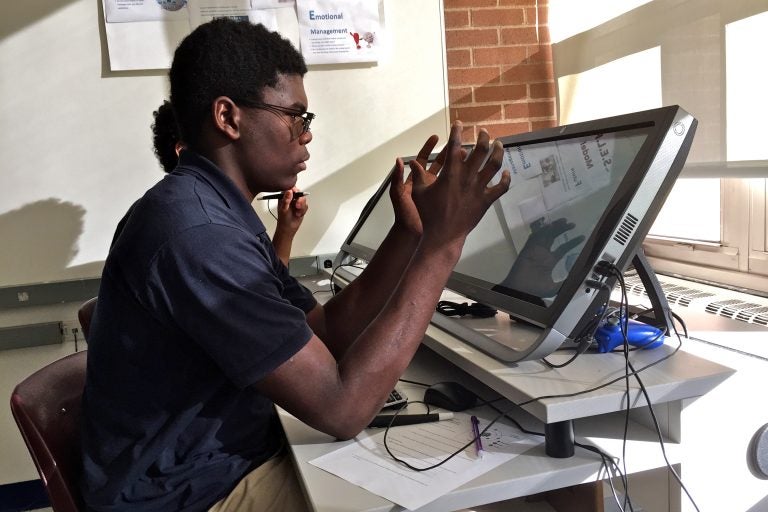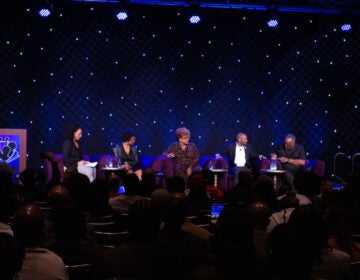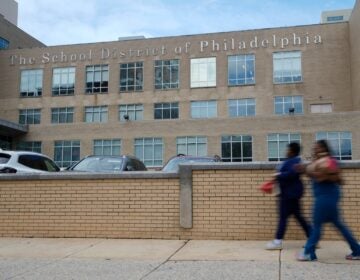To reach special needs students, Bucks County school turns to virtual reality
There is a classroom in Morrisville, Bucks County unlike any other in Southeast Pennsylvania. Administrators think the technology inside could unlock students' potential.

Oswald Darway, a 10th grader at Valley Day School, works with a virtual reality program. (Avi Wolfman-Arent/WHYY)
Sophomore Oswald Darway cradled the air in front of him like it was a crystal ball.
To the outside observer, he appeared to hold nothing. But Darway, outfitted with a pair of 3D glasses, saw something magical hovering before him: a supersized carbon atom.
“I’m just… I don’t even know,” Darway said. “It’s just so amazing to look at.”
This moment of fascination came from a classroom unlike any other in Southeastern Pennsylvania.
Earlier this year, the Valley Day School in Morrisville, Bucks County outfitted their computer room with 15 virtual reality devices made by a California company called zSpace. School administrators say they now have the area’s first “mixed reality lab.” And they believe their new technological toys can unlock the learning potential of an especially challenged student group.
“This is really one of the best things going for us,” said longtime Valley Day teacher Paula Tenaglia.
Despite its tony-sounding name and flashy tech, Valley Day isn’t an oasis of privilege. Instead, it’s an approved private school, meaning public school districts pay Valley Day to serve special needs students they can’t effectively educate. The school focuses on kids with emotional and behavioral disabilities. Children who end up at this unassuming, ranch-style campus in suburban Bucks County typically struggle to focus or stay engaged. Some were serial troublemakers at their previous stops.
Valley Day tries to steady its students emotionally and make up the academic ground they’ve inevitably lost while dealing with discipline issues.
“We have, like, a safety plan that help us control our emotions, our anger,” said Darway, 16.
Considering the needs of their student body, Valley Day teachers think virtual reality can be an especially effective tool.
The zSpace device looks like an oversized iPad with its own stylus pen and pair of 3D glasses. The glasses make images appear as though they’re hovering above the screen’s surface, kind of like the holograms of science fiction lore. The pen allows users to manipulate images — turning them, dissecting them and otherwise dragging them about the virtual environment.
The possibilities are not, at this point, infinite. The devices come preloaded with hundreds of objects — some animated, others still. But it’s not as if the user can look at any digitized image in the third dimension.
And while some images can be dissected in seemingly endless combinations, others are less mutable. For instance, a model heart loaded onto the device can be picked apart in hundreds of ways. But a tuba can only be turned and twisted, not broken down.
Last Friday, teacher Diego Carmona had his students deconstruct a carbon atom, using the lesson to hammer home concepts learned in past classes on the periodic table. Students could see and rotate the electron paths of a single atom, or pick through a diamond structure to see how carbon atoms interact with one another.
“A lot of our students are tactile learners so they do a lot better with hands-on manipulation,” said technology teacher Eric Dixon. “Of course we can’t give them an atom and have them turn it around and have them look at it physically, but having this technology helps them a lot.”
According to a 2014 article from Education Week, researchers and educators have been fantasizing about the educational possibilities of virtual reality since the early 1990s. Much of the optimism has focused specifically on how the technology might help special needs students. Despite the hype, however, virtual reality has struggled to make significant inroads.
Valley Day hopes to show the way. The school’s ten classes each rotate through the mixed reality lab about once every two weeks. Some teachers, like Carmona, craft their own lessons. Others rely on the technology teacher, Dixon, to dig up age-appropriate activities.
One day, Dixon taught a trio of eight-year-olds about instrument groups using a lesson already embedded in the zSpace tablet.
One of the students, Jayden Hychalk, struggled at one point with the stylus pen, insisting to Dixon that the technology “hates” him. Dixon chuckled and recommended he move a bit further from the screen.
Jayden’s focus wavered throughout the lesson. At one point he began making the sound associated with a brass instrument, morphed it into a cat’s meow and followed off on a tangent about kitties.
But Jayden remained in his seat throughout the lesson and never stopped fiddling with the technology. Paula Tenaglia, one of his teachers, considered it a victory.
WHYY is your source for fact-based, in-depth journalism and information. As a nonprofit organization, we rely on financial support from readers like you. Please give today.





